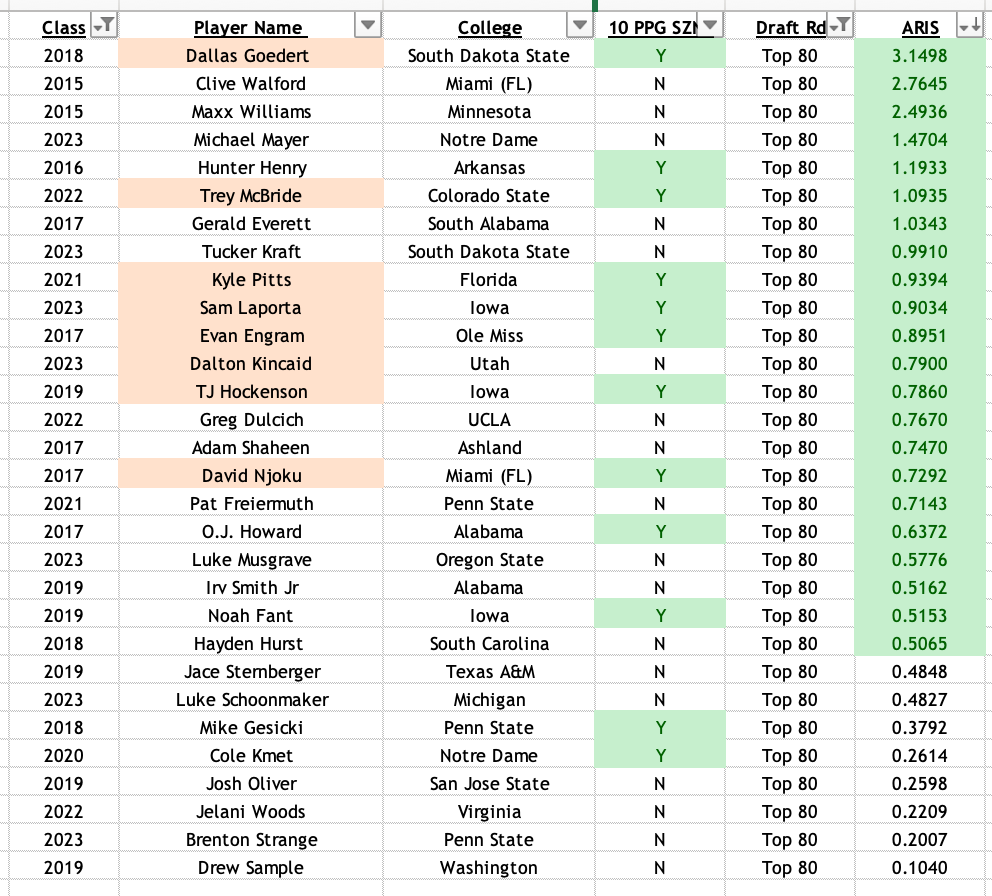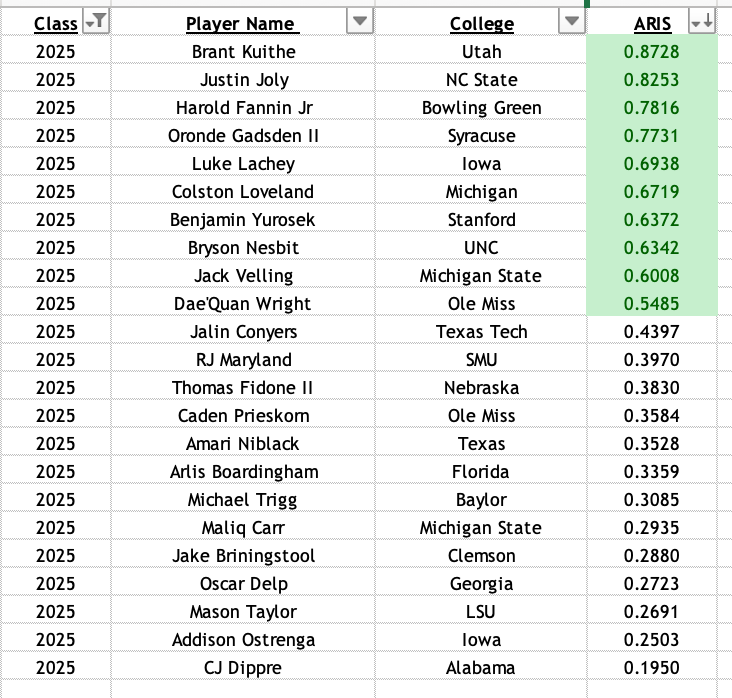Intro To ARIS: TE Edition
After the season ended, I started analyzing numbers and summarizing the events that took place over the course of the last five months. What I kept coming back to most was how Puka Nacua flew under the radar for the majority of the draft process. Of course, no one expected he would end up with the greatest rookie season of all time, but why wasn’t he touted more than he was? Why wasn’t the drum beat louder? What did I (or we) miss in the process of the evaluation that allowed him to slip through the cracks?
Rather than looking at multiple metrics to determine productivity and efficiency, what if there was a single metric that could encompass all aspects and provide a true representation of a player's worth?
These questions are what prompted me to create a metric I am calling ARIS, or Aggregate Receiver Impact Score so a player like Nacua doesn’t slip through the cracks again.
*Now, a player's production and efficiency are only part of the equation. There are many other factors that help make up a prospect profile, like athletic testing, film study, and draft capital, so this is not an end-all, but it can certainly help us determine who we should be drafting on our fantasy teams.*
The ARIS metric is applicable to both wide receivers and tight ends. Although I am still in the research phase for the WR version of this metric, initial results suggest that players like Puka Nacua (and Stefon Diggs) would not have gone unnoticed as they did before. By using this metric, I could have identified them earlier in the process as players to target in our rookie drafts. I will have the WR version out at a later date.
But for now, let’s take a look at the TEs.
So, what is ARIS?
ARIS is a metric that aims to assess the performance of wide receivers and tight ends. It goes beyond just measuring the number of catches or yards gained, taking into account a more comprehensive evaluation of their overall contribution to the game.
Here’s a breakdown of what ARIS measures.
Efficiency: First, the analysis focuses on the effectiveness of each player every time they run a route. It's similar to measuring a worker's productivity per hour. In this case, a player who gains a lot of yards each time they catch the ball is considered efficient.
Production: The next factor it considers is a player's overall contribution to their team's passing game. This analysis considers both the quantity and quality of their work, similar to how an employee's evaluation would not only be based on their efficiency but also on their total output over a project.
Combination: ARIS is a comprehensive score that combines two aspects of a player's performance. It takes into account both how good a player is on a per-route basis and their overall contribution to the team's success through the air. By looking at both aspects, ARIS provides a more complete picture of a player's performance than just focusing on one metric.
Purpose: The goal of ARIS is to differentiate players who not only produce impressive numbers but also utilize their opportunities effectively. It is designed to help fantasy football managers make informed decisions when choosing which players to select. The objective is to pick the players who will contribute the most fantasy points based on their on-field performances.
There are some people who believe that the production of a tight-end doesn't matter and that when deciding who to draft, we should only consider their athletic testing scores and draft capital. However, I disagree with this viewpoint, as tight-end production is significant in both real football and fantasy football. However, the way we value it can differ from wide receivers due to the unique role tight-ends play on the field.
In my TE database, I have 226 prospects since 2015 (including the 2024 class). This is a combination of drafted players, undrafted players, FCS, and FBS players. I believe in a ‘no stone unturned approach’ when it comes to evaluating prospects.
Of the 226 prospects, 68 TEs have an ARIS score of .5000 or greater.
Since 2015, there have been 21 different TEs to have a season of at least 10 PPG.
17/21 had an ARIS score of .5000 or greater.
Of the current top 12 dynasty TEs, per FantasyCalc, 11/12 have an ARIS score over .5000. (The 12th is Travis Kelce, whom I don’t have a complete profile on.)
Players drafted in the top 80 since 2015.
Players drafted in rounds three and four since 2015.
Players drafted in rounds five, six, and seven since 2015.
Finally, UDFAs since 2015.
It is important to keep in mind that having an ARIS score of over 0.5000 does not necessarily guarantee success, but it should be viewed as a minimum threshold that we expect our tight ends to achieve in terms of production while in college. Having a score below this dramatically decreases the odds of a player becoming a viable fantasy asset.
As I was compiling the data, I noticed that there were more FCS players who scored above .5000 than I initially anticipated. This can be attributed to a few factors. For instance, some FCS schools do not have high volume pass offenses, which makes any receiving production look good in terms of market share. On the other hand, some schools have extremely high pass volume, which can inflate numbers, potentially making a prospect look better than he actually is.
Of the TEs since 2015 to post at least one 10PPG season, only two were FCS TEs.
Robert Tonyan's 2020 season was an outlier compared to the rest of his career due to Aaron Rodgers' third MVP season, during which he threw for 48 TDs. Tonyan had 11 receiving TDs that season.
For fantasy purposes, Dallas Goedert has been the only ‘reliable’ FCS TE in the last decade to come into the NFL.
The caveat to this is draft capital, as Tonyan was a UDFA, and Goedert was a top 80 selection. The key takeaway is to be cautious of FCS TEs until we know their draft capital. (Buy Tucker Kraft)
Adam Shaheen, Dallas Goedert, and Tucker Kraft are the only three FCS TEs with an ARIS score of .5000 or greater to have been drafted in the top 80 since 2015.
With scouting season well underway, this is how the 2024 rookie class stacks up.
Two FCS TEs scored well - Illinois State Cam Grandy, who was invited to the Shrine Bowl, and Owen Glascoe from LIU, who, to my knowledge, was not invited to any pre-draft bowl.
Finally, looking ahead to the 2025 TE class. *Keep in mind the scores are subject to change.*












